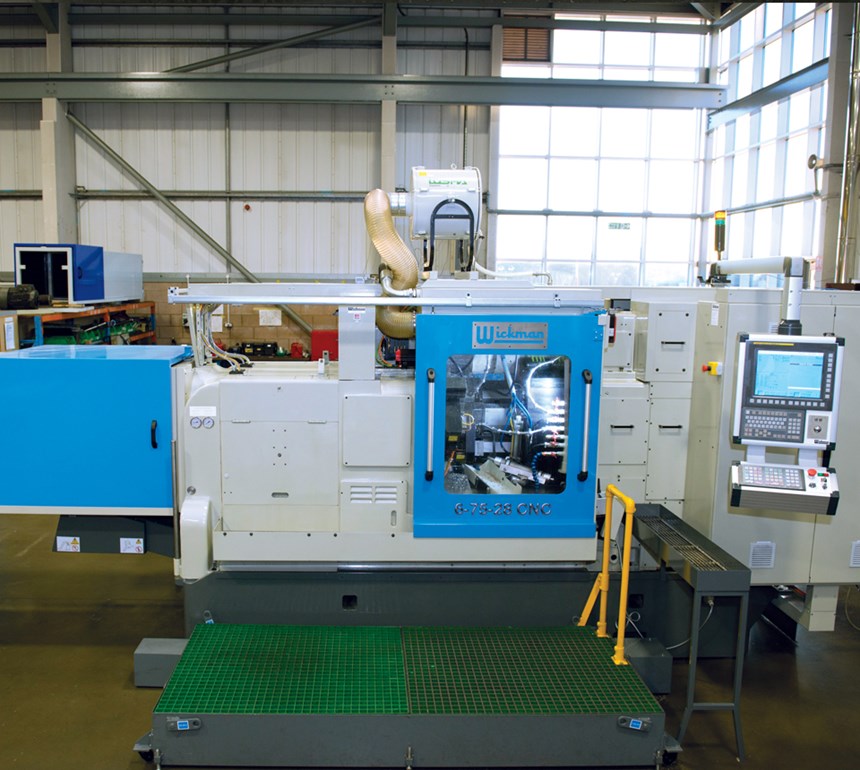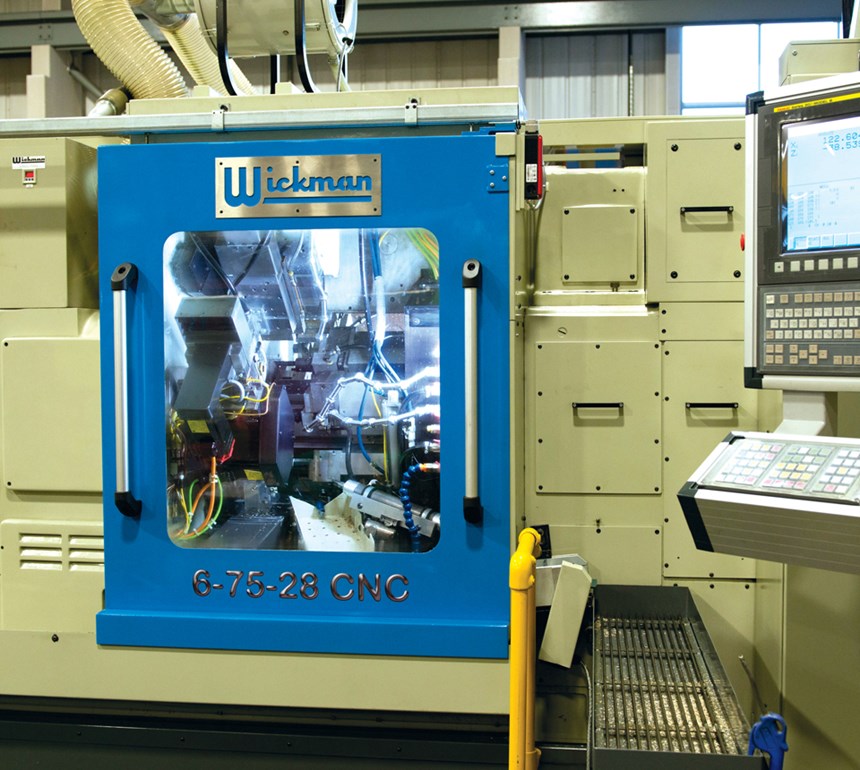A Collaborative Approach to Custom Machine Design
Conventional wisdom says multi-spindles equal high volume. That’s not necessarily true, as this U.K. project demonstrates.
Imagine someone working at the cutting edge. They are a visionary, a lone inventor with an idea that others may have dreamed of, but never had the drive to make real. They beaver away for years until one day they unveil their finished article, and we all step back and wish we’d thought of it.
The real world doesn’t work like that. The lone pioneer is a rare creature, especially in manufacturing, where investment can be considerable and market potential uncertain. The real world has commercial pressures, time constraints and day-to-day demands. No matter how much we’d love to play the part of the daydreaming radical inventor, we’ve got the regular stuff to sort out first. In this world, it’s adaptation that’s the usual route, not revolution. Few organizations can afford the risk of striking out into the unknown or survive the roller coaster of repeated failures, modifications, testing and retesting.
All this said, the engineer in all of us loves nothing more than a challenge. And when that challenge comes from a customer a company has worked with and supported for half a century, any business would want to step up to the mark. Even though they may want something out of the ordinary, there’s no isolation. A group is created that wants to solve a problem and deliver a workable solution. We’re not talking about a pipe dream—it’s an idea with potential. If one customer needs this solution, it’s likely others will, too. This is how Wickman, the producer of high volume, multi-spindle turning machines, felt about its customer, CMP.
Low-Volume Production
For some products, CMP’s customers require small batch sizes at short notice, which can be disruptive for a high-volume shop. To meet this demand and provide good customer service, CMP traditionally has had to manufacture large batch sizes, which meant high, expensive inventory levels that were often based upon the potentially inaccurate prediction of customers’ future orders.
While it is more normal to hear component manufacturers clamoring for faster cycle times and for the perceived efficiency of large batch sizes, CMP was posing a subtly different question: “How do we produce small quantities, economically, in the shortest possible time?”
CMP is part of the British Engines Group and is a U.K.-based manufacturer of cable glands, adapters and blanking plugs for industrial, marine and explosive environments. The company works with brass, aluminum and steel, and for half a century has trusted Wickman for its turning machines. Its equipment comprises a bank of 26 multi-spindle machines of various sizes, regular single-spindle CNC lathes and rotary transfer machines, which are used for the company’s highest-volume products.
With standard single and twin CNC machines unable to produce the required small batches of component parts in a fast enough cycle and setting time, Wickman proposed a solution—a re-engineered, easy to set and control multi-spindle machine.
It was a major change in thinking. For years, the impetus had been toward reducing cycle times. But for these particular components, their low volumes took standard multi-spindle machines out of production because they were requiring too much setup time.
Ron Dodd of British Engines, and Suresh Talwar, a senior production engineer from CMP, contacted Wickman about the issue in 2010 and held the first of what would prove to be many meetings. Their suggestion was for a fully CNC controlled six-spindle machine that could be set up in times ranging from a few minutes to no more than 90 minutes, including a full collet and bar change. On top of that tall order, they wanted a machine that could shift seamlessly from one part to another when machining from a compatible hexagon barstock of the same diameter. Their demands were tough, but given what they hoped to achieve, essential.
A New Approach
It soon became clear that the ideal solution is a machine configured in such a way that it could produce different parts with a seamless change-over time, thus facilitating small batches with minimal setup and tool-up time. Although there would be some compromise of the optimal cycle time, this is irrelevant given the low volumes and is more than offset by the savings in change-over time. CMP was talking about a machine that could make feasible the low-volume, high-value output approach. The project would not be straightforward, but its potential represented a big step forward.
The Wickman team and CMP settled down to list the specific requirements, including the idea of multiple components from the same barstock, quick setup time and exceptional precision. The last item on the list—the machine should be user-friendly—was non-negotiable. Despite the complexity of what the machine was expected to do, using it had to be as simple as possible to accommodate the variances in operator skills. The development of software to control the prototype was critical.
With multiple interested parties, it would have been too easy for the different parts of the project to be developed separately, but the team stuck to the initial step-by-step plan, knowing time invested up front in careful design and planning would pay dividends in the end—more tortoise and less hare.
Beginning the Build
The starting point was based on an existing Wickman configuration. The machine was to have six spindles, 75-mm diameter capacity, 28-axis CNC control and compound axes on all of the cross and end-working slides.
To ensure the project’s success required going back to first principles to ensure full compatibility between controller and machine. Furthermore, with CMP’s stringent quality requirements, there was no room for any compromise in precision or machining accuracy. CMP engineers had requested that the machine should use a FANUC 300i controller, which was the most sophisticated model of the FANUC range at the time. The standard controller has a dual CPU and is capable of controlling 28 programmable axes in 11 paths.
The project was likely to represent a substantial drain on Wickman’s staff resources. Trying to fit it alongside the day job would interrupt momentum. The goal was to prove not only that the technology could be made to work, but also that it could be valid commercially and have potential in a wider market. With these issues in mind, the team applied to the U.K.’s Technology Strategy Board for funding to assist with software development. The project was recognized as being consistent with the board’s aim of driving innovation and showed the potential to deliver flexible and adaptive manufacturing. The funding that was awarded allowed the ability to set aside the time needed for testing and validation.
What followed was a period of intense planning, followed by an extensive period of detailed design, development and manufacture, followed by two months spent on the initial programming phase. Then came a cycle of testing, modifications and reprogramming that took several more weeks. Finally, Wickman and CMP had an end result that met and even exceeded their expectations. They had a machine producing a quality product with little or no change-over setting time and with cycle times that, while not matching a conventional multi-spindle machine, were still three to four times faster than the average standard or twin CNC machines.
“With little or no setup time, this machine has removed the need to produce low-volume component requirements in large batches on high productivity multi-spindle Wickman machines,” Mr. Talwar says. “It has allowed CMP’s low-volume production requirements each month to match the order book and eliminate the need for large inventories.”
High Concept Operation
The original target was to purchase a machine able to switch seamlessly from one part to another, without manual intervention, that was suitable for the production of small batch sizes. Where just one part is required, the machine can produce any quantity—from six to multiples of different components that consume the full barstock.
For a long time, multi-spindles have been seen as the tool for rapid, precision volume production, but that’s not always what the component manufacturer needs. By looking at the issue from a different angle, efforts can be focused on the development of a machine entirely suited to its application. In addition, the resetting time had been slashed for the machine from the four- to 16-hour norm to something much more manageable, which has helped the customer free up its capacity and reduce stockholding.
The result, Mr. Talwar says, is the elimination of the “lottery” of holding huge stocks of components and trying to anticipate customer requirements. “It has instead provided substantial flexibility, which has significantly contributed to our aim of continuous improvement,” he says, “including on-time deliveries and excellent customer service.”
Collaborative Concept
They say necessity is the mother of invention. CMP’s requirement forced the team to prove that there are ways other than volume to make multi-spindle technology efficient and cost-effective. It was done through collaboration, working as a team to seek and find support and deliver a practical solution. For more information from Wickman Machine Tool, call 847-458-6400 or visit wickman-usa.com. For more information from CMP, visit cmp-products.com.
Chris Barrett is managing director of Wickman U.K.
Related Content
Accessory Speeds Centering Align Drills on CNC Multi-Spindles
The CenterMaster accessory is designed to streamline the setup and changeover process for CNC multi-spindle lathes.
Read MoreStriving for Faster Changeovers for Multispindles
A multispindle platform designed to combine the high production speed of a cam-driven machine with the precision and repeatability of CNC also includes technology to speed set ups for new jobs.
Read MoreWhere Machining Precision is a Family Tradition
This century-old manufacturer is a case in point of how company culture and openness to adopting new technology paves the way to success.
Read MoreMultispindle Automatic Lathe With Full System Concept
PMTS 2023: Tajmac’s Penta TMZ 518 is a five-spindle automatic lathe that features an island concept which offers the machine as a package.
Read MoreRead Next
Emerging Leaders Nominations Now Open
Here’s your chance to highlight a young person in your manufacturing business who is on the path to be a future leader moving your company forward.
Read More5 Aspects of PMTS I Appreciate
The three-day edition of the 2025 Precision Machining Technology Show kicks off at the start of April. I’ll be there, and here are some reasons why.
Read MoreA Tooling Workshop Worth a Visit
Marubeni Citizen-Cincom’s tooling and accessory workshop offers a chance to learn more about ancillary devices that can boost machining efficiency and capability.
Read More










.jpg;maxWidth=300;quality=90)



.jpg;maxWidth=300;quality=90)









